David Bowie: "I've only ever showed one person how to play Rebel Rebel properly. I was downstairs in a hotel and there was some guy playing guitar – dreadful metal stuff. He started playing Rebel Rebel. I went stomping upstairs, and it was John McEnroe”
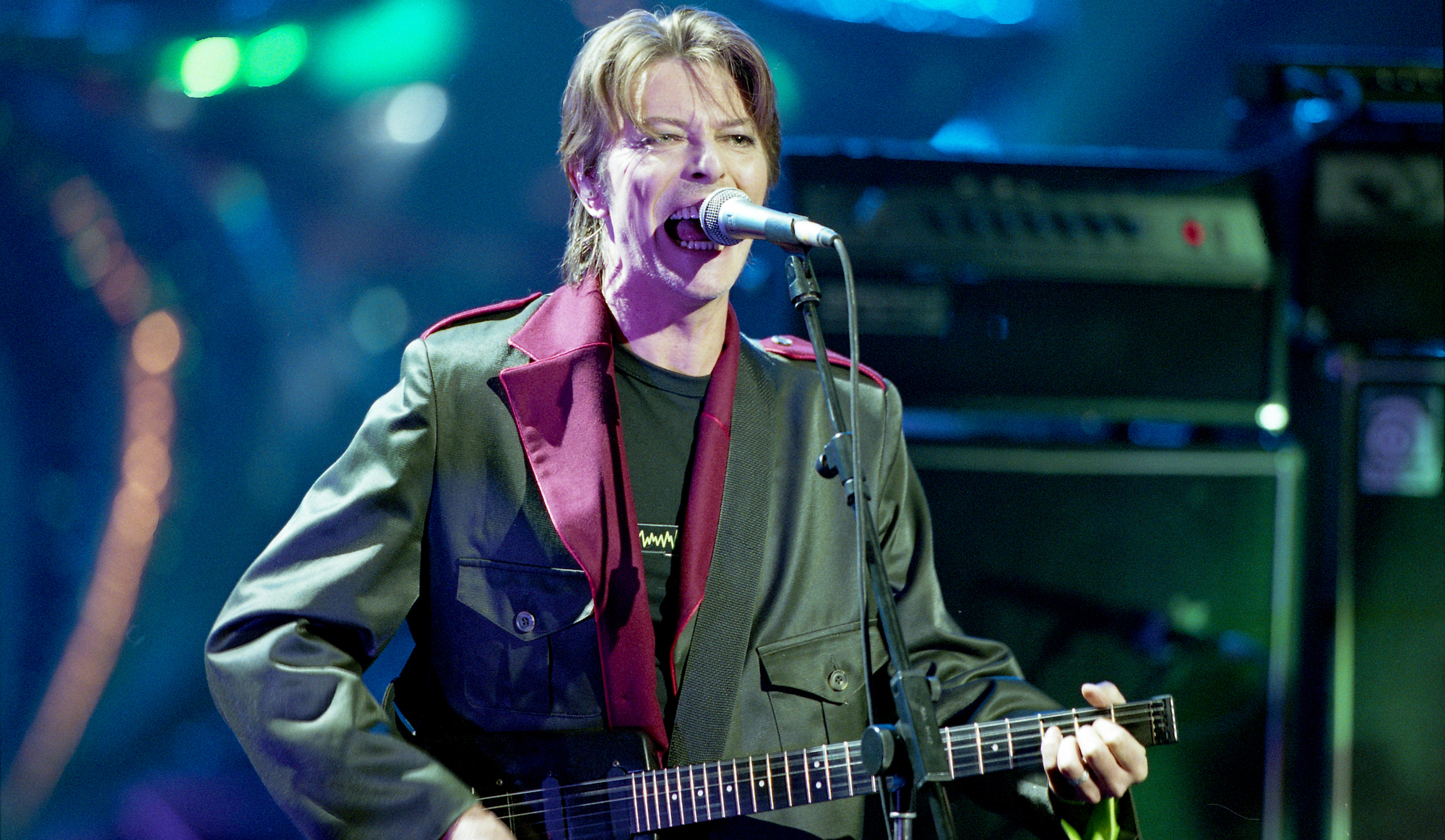
The following interview with David Bowie and Reeves Gabrels was originally published in the June 1997 issue of Guitar Player.
“You'll need headphones,” warns David Bowie.
Is his band that loud? Far from it. There are no floor monitors or P.A. columns in this Manhattan rehearsal studio. Everything goes direct to a mixing board before returning to the band via hearing-aid-style in-ear monitors. The band plays along with taped tracks, dropping in and out of the mix. Without the cans, all you hear at times is Bowie's unamplified singing and a bit of Reeves Gabrels' mutant Parker Nitefly.
Unlike many who have gone the play-to-tape route (including, some would argue, the larger 1995 incarnation of the Bowie band that supported the Outside album and toured with Nine Inch Nails), Gabrels, bassist Gail Ann Dorsey, drummer Zachary Alford, and keyboardist/'70s Bowie vet Mike Garson create an exciting band feel, not only synching with the prerecorded tracks but stretching against them in dynamic, off-the-cuff fashion. Maybe too off the cuff?
“Reeves is giving all sorts of lovely lines to choose from today,” taunts David when Gabrels fails to render the exact part he played on Dead Man Walking, a tune from Bowie's new Earthling album. Reeves shrugs: “I thought the job description said 'loose cannon.'”
It's easy to understand why even a player with Gabrels' extraordinary technical skill finds it challenging to replicate the disc. Earthling, widely regarded as Bowie's best release in many years, is a high-tech tour de force that fuses over-the-top guitars with some of the electronic beats that have driven recent European pop, particularly the feverish collision of deep bass and hyperactive percussion known as 'jungle' or 'drum and bass.'
Produced entirely on hard disk by Bowie, Gabrels, and engineer Mark Plati, the tracks shine with the clean edges and slap-your-face edits idiomatic to that cut/paste/loop medium.
All the latest guitar news, interviews, lessons, reviews, deals and more, direct to your inbox!
Gabrels, too, has gone digital, abandoning his beloved Mesa/Boogie amps and overstuffed effects rack to record almost exclusively through a Roland VG-8 system. Bowie's main instrument was a Fernandes ZO3, a cheap travel guitar with a built-in amp and speaker. Gabrels shares writer's credit on most tracks.
The band launches into Scary Monsters, substituting a skittering groove for the ominous clank of the 1980 original. Gabrels provides a startling array of anarchic shrieks and scrapes, but caps the song with a high-precision shred solo as technically excessive as anything from the late '80s.
The performance spans the paradoxical poles of the guitarist's musicianship: his phenomenal technique and his willingness to short-circuit it. He's brought the same technical ambivalence to every Bowie record since 1987, as well as his collaborations with Dave Tronzo and Modern Farmer, the 1995 solo album The Sacred Squall of Now, and an in-the-works project featuring Bowie, Frank Black, and Dave Grohl.
Bowie seems pleased by the performance. He adjourns rehearsal early, then scurries over to a large suitcase crammed with cassettes, CDs, videos, and magazines. He hums with excitement as he pops in a DAT of new Bowie remixes crafted by Moby and Mark Plati: “Isn't this wonderful? Isn't this great?” His conversation careens in a dozen directions at once – recent records, literary anecdotes, the current fashion collections, rock gossip.
The next morning the band performs on The Rosie O'Donnell Show. O'Donnell sets up a running gag about how Bowie never plays the old songs, particularly her favorite, China Girl. David emerges and serenades her, strumming an acoustic and substituting the word “Rosie” for “China.” The band plays Seven Years in Tibet, and tapes Dead Man Walking and Scary Monsters for broadcast later in the season.
After the show concludes O'Donnell asks David to repeat a filthy joke he'd told her. When he demurs, she shares it with the studio audience, adopting her best Bowie accent.
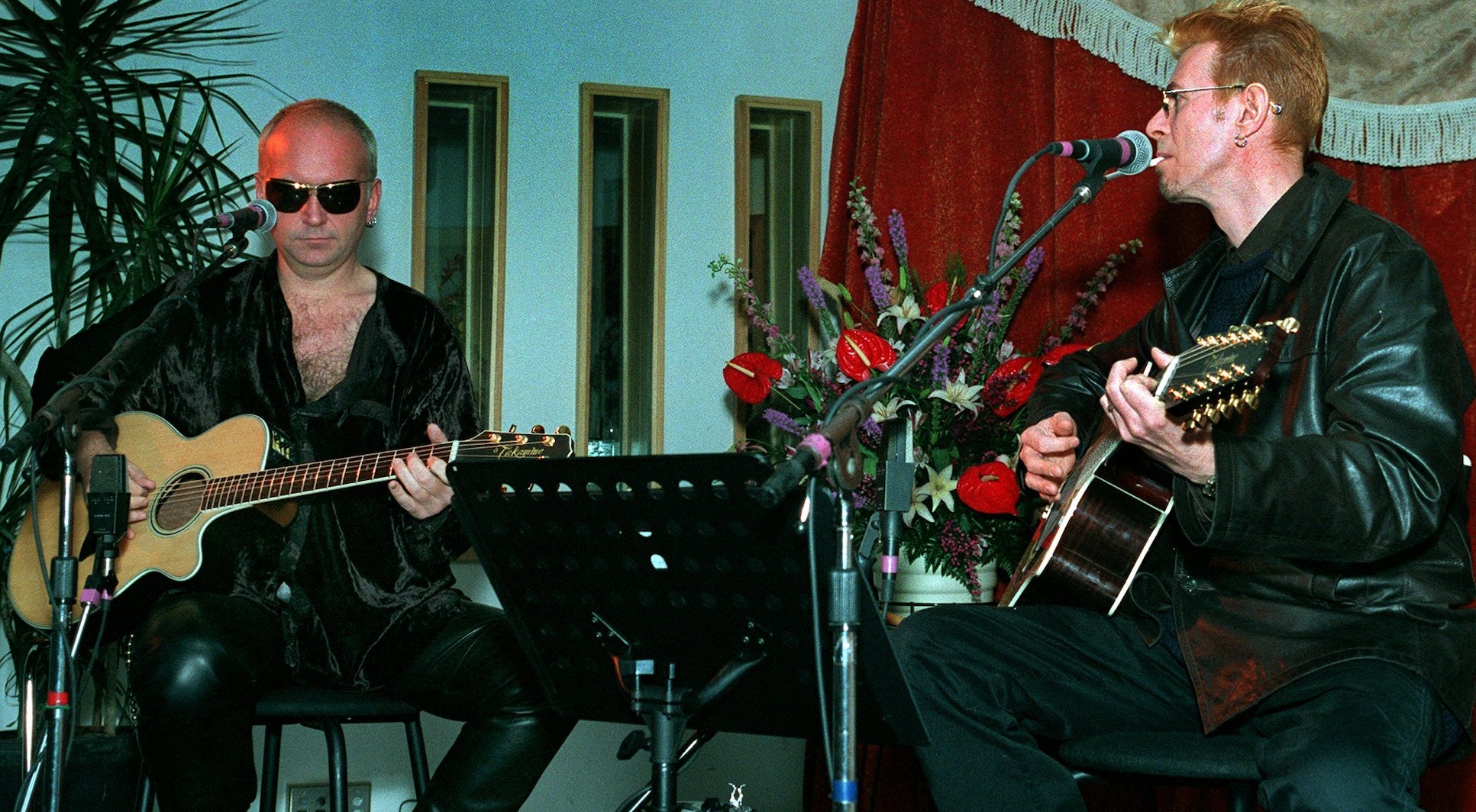
After the show David and Reeves meet at a nearby hotel to discuss their decade-long collaboration. The two have developed a near-psychic rapport, each completing the other's thoughts or amplifying his metaphors. When discussing music, both hasten to draw analogies from other arts, citing architecture, painting, fashion design, and theater. Sandwiches arrive. “Look, David – you got ham,” Gabrels says. “I'd rather be a ham than a turkey,” sniffs Bowie.
Making technique sound ugly
You've said you were drawn to Reeves for his ability to let go of his musicianship. Does a player need to have it to let it go?
Bowie: “Yes. There's a certain self-security factor involved. Musicians who are involved with their instrument to the extent that there are no thought processes involved in their playing have far less of a problem reducing down and deconstructing what they're doing, making technique sound ugly and rubbing it up the wrong way.
“Guitar players who are less confident of their abilities are more likely to regard it as just sounding like noise if you ask them to do something that's not 'musicianly.' Guys who are really into it can let go more easily.
“[Robert] Fripp is like that. He seemed to enjoy the process, and I think he was quite bemused by some of the things I asked him to do – things like asking him to imagine he was playing a guitar duel with B.B. King where he had to out-B.B. B.B., but do it in his own way. That was on It's No Game, Pt. 1 [from Scary Monsters].
“Reeves is much the same. You can give him a mental trip and he will benefit from it and enjoy it, whereas a lesser guitarist is more likely to be worried by it. The most obvious example on Earthling is the solo from Looking for Satellites.
“I told him I only wanted him to play on one string at a time. He had to stay on the low E string till the chord changed, then he could go up to the A. When it changed again he could go to the D. He was hemmed in by the chord until it changed, and that made his run-up most unorthodox. He just loved it. Anyone else would say, 'Let me practice it a few times.'”
Gabrels: “When I got to the section where I was supposed to stop, I just thought, 'Fuck this!' and broke out of the rule, playing through the chorus. And David said, 'That's great.' Because of the restriction David put on me, it has a nice developmental curve, even though I'm overplaying. It has a nice orgasmic release.”
That ambivalence about “overplaying” is one of your defining traits.
Gabrels: “I want to have the chops to play what I hear, but I don't want technique to lead me by the nose. I suppose the ambivalence came with time, since by the time you acquire a skill, you might have outgrown the reason you wanted it in the first place. But there is also a competitive side to my personality. Not like I have to have what another person has, but in the late '80s, I needed to be able to do the Vai/Satriani/Yngwie thing because of my desire to be able to play whatever I wanted to play.”
I see the guitar neck as a landscape. I see length and barrenness. I see each note or cluster of notes as objects within a landscape: a tree, a fence
David Bowie
You both tend to describe music in visual terms.
Bowie: “Ever since I was very young, I've seen music in visual terms. I see the textures that I'm hearing, and I equate certain sounds with the relative roughness and smoothness or density and transparency of color. I really see it in painters' terms.
“The idea of, say, Rimsky-Korsakov developing a 'color organ' – a primitive thing with colored glass and candles – always made perfect sense to me. It always made perfect sense that you could go to, say, E minor, and it would have a particular hue.”
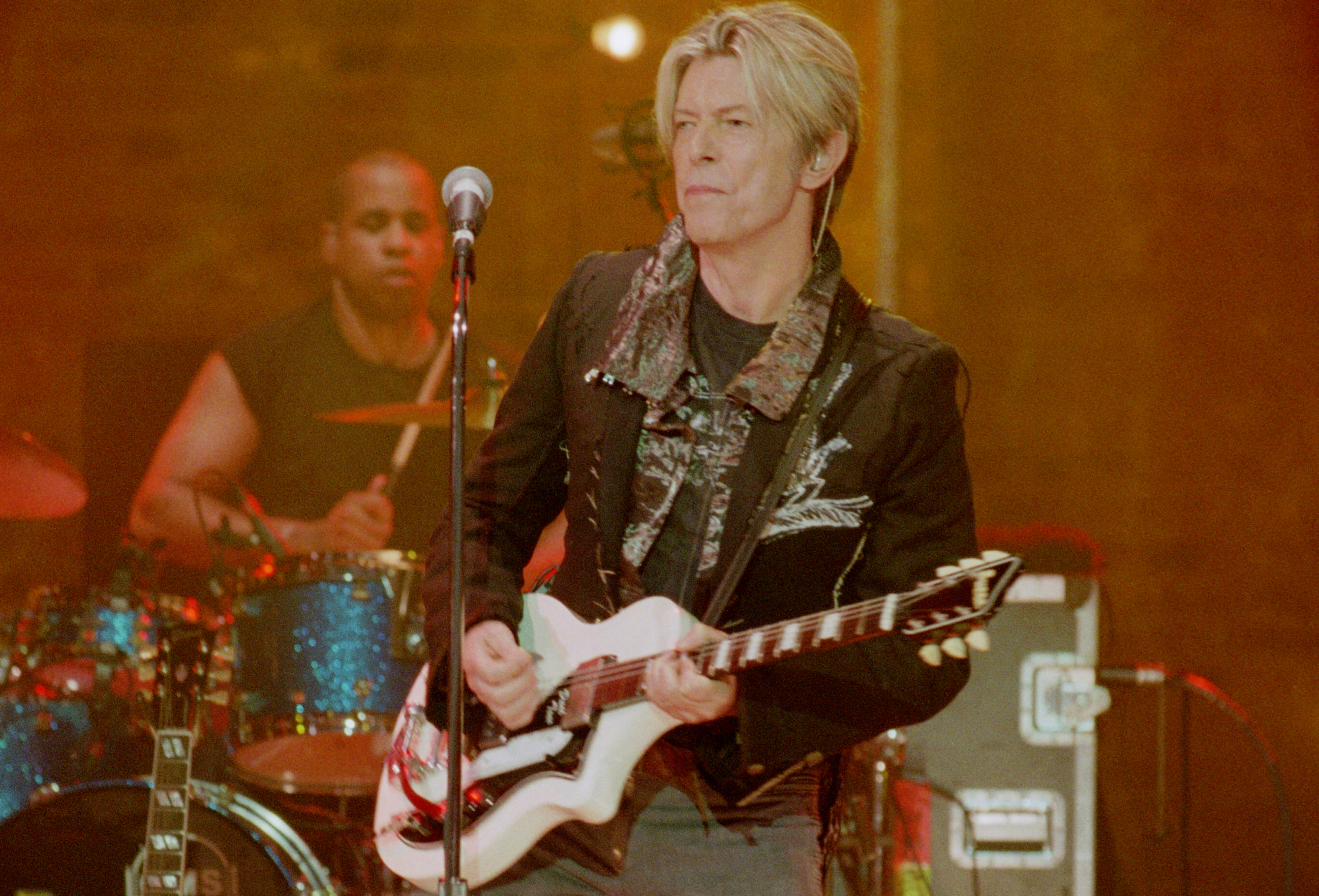
“I see the guitar neck as a landscape”
The guitar neck is also very graphic.
Bowie: “I see the guitar neck as a landscape. I see length and barrenness. I see each note or cluster of notes as objects within a landscape: a tree, a fence.
“I describe instrumental parts in visual terms: 'The first part should be like a moor with a light fog. As we approach the chorus, it shouldn't emerge as a clear figure, but as an approaching object in a darker gray than the gray of the fog. It takes on recognizable features by the time it gets in close to you.' And then I'll make a hand gesture to indicate the sort of shape it should gradually take on. I just happen to be lucky to be working with people who understand what the fuck I'm saying!
“That's what I do as a producer. Give me five knobs and I'll hit the wrong two ones, but I am good at knowing exactly what the album looks like. I'm also good at opening musicians to areas of their own technique or creativity that they might not have looked at before.”
I spent a lot of time taking apart rock songs. I have no technique, but I have very good timing
David Bowie
Gabrels: “The very first thing we ever did together was a remake of Look Back in Anger [now a bonus cut on the CD version of Lodger]. When I walked in you had keyboard pads at the beginning and end, but no guitar. Your reference was architectural. You said it should be like a cathedral.”
Bowie: “Right. I said the central part should have a spire, but it should have flying buttresses that are as strong, but not as emphatic, as the spire itself. We literally approached it that way. Reeves and I both have visual arts training, and that may be why I don't have the same problems talking things over with Reeves than I could with other guitar players. I can talk with Reeves at a very different level.”
Reeves says your Dead Man Walking riff is based on a pattern Jimmy Page showed you back in the '60s. There's an aspect of your own playing that's a throwback to the coffeehouse/garage roots of rock guitar, when technique was less scientific than it is now.
Bowie: “Completely! My guitar playing hasn't moved with the times at all. I use the same chords as always. But I do know a lot of them, and I'm able to put them together in interesting juxtapositions. Any time I did spend being disciplined was learning how chords work together. I spent a lot of time taking apart rock songs. I have no technique, but I have very good timing.
“The guitar was my orchestra when I would play solo shows in the '60s. I'd set up two Selmer P.A. columns on top of my little bubble-shaped Fiat 400. I'd drive up and down the M1 doing shows with just 12-string guitar. But I was never interested in becoming a 'guitar player.'
“I have no lead guitar abilities. I can't play anything at a party. I don't know one of my songs unless I'm learning for a tour. I actually had to learn that little fragment of China Girl I played this morning. But Reeves can play anything. I expect he can play the entire Elton John songbook.”
Gabrels: “Yeah, Daniel, Rocket Man...”
Bowie: “'Daniel Rocket Man'? Sounds interesting!”
Gabrels: “Sort of a Charles Ives thing.”
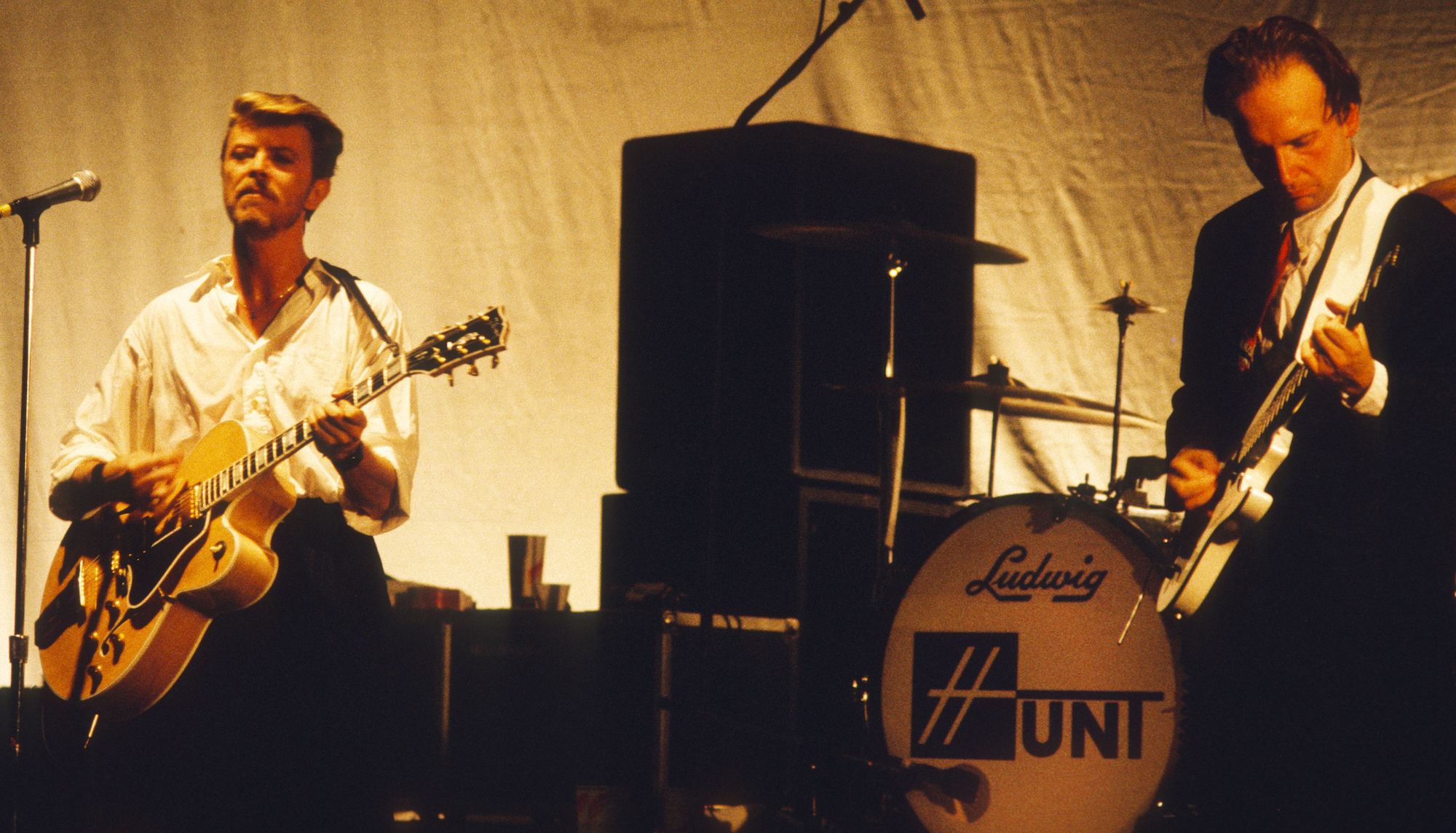
As much as David disparages his own playing, Diamond Dogs was one of his great guitar albums. A lot of people assume it was a Mick Ronson record, but it was all David.
Bowie: “During that period when I left the Spiders [from Mars], I knew that the guitar playing had to be more than okay. That couple of months I spent putting that album together before I went into the studio was probably the only time in my life where I really buckled down to learn the stuff I needed to have on the album. I'd actually practice two hours a day. I knew the sound in my head, and at that time I didn't know musicians who could carry it off.”
And later you met such musicians and felt you could pass the baton?
Bowie: “I needed musicians to play Diamond Dogs live. Of course they played it differently. Some of my lines had sounded almost proto-punk because of my inabilities as a virtuoso. But by the time they took it onstage, they were playing it in a very musicianly style. Something was lost because of that. That album had a quality of obsession with what I wanted to get over. That's not there when I hear the gigs from that period. It was originally played with a singular vision, and that singularity is desperate, almost panicked.
“The vulnerability of playing something you think is important is very endearing. You'll never get that when you get proper musicians to play the stuff. They play it too well and with too much fluidity. There's not that sense of awkwardness about the structures. So to me, Diamond Dogs was never played well onstage, or at least never with the sensibility that the album had.”
The Rebel Rebel riff is so simple, but so perfect.
Bowie: “It's a fabulous riff. It is! Just fabulous! When I stumbled into it, it was, 'Oh! Thank you!' I've only ever showed one other person how to play it properly. I was in a hotel in London about 15 years ago. I was downstairs, and there was this awful row coming from upstairs, some guy playing electric guitar. He was playing dreadful heavy metal stuff, and then he started going into his version of Rebel Rebel. I went stomping upstairs, and it was John McEnroe.”
“I tried things until I found something cool”
Any kid could play the "Rebel Rebel" riff. The opening riff of [Earthling's] Little Wonder may be just as striking, but it is quite literally unplayable.
Bowie: “It's a synthetic piece of work. It was guitar sounds transferred to keyboard. It gets past the guitar, though Reeves can actually play it.”
Gabrels: “The three-note guitar figure is assembled from separate performances. The assistant engineer and I made up a DAT of a half-hour of guitar stuff I like to do, things like the whammy aspect of the VG-8. I figured if we were going to use samples, we might as well make our own. Then we loaded the samples onto the keyboard, let an eight-bar section of the rhythm run over and over on the computer, and I tried things until I found something cool.
“The first note is me popping a low E string with an envelope filter and distortion on the VG-8; the second part is the same sound, but playing another E two octaves up and hitting the whammy bar so it flutters. The third note is a high E at the 24th fret with the Fernandes Sustainer on my Parker set an octave above that. It gets squeaky up there – it sounds like two pieces of metal rubbing together.
My playing on this record is like making head cheese: You put the parts in, boil it, and scrape off the distilled thing that comes to the top
Reeves Gabrels
“My playing on this record is like making head cheese: You put the parts in, boil it and scrape off the distilled thing that comes to the top. Now, of course, I have to learn how to play it live. My Nitefly only has 22 frets, so to get the high E I use the VG-8 to tune the G string up an octave, so I have that same high E at the 21st fret. Having to figure out how to play parts that have been digitally manipulated has definitely helped my playing evolve.”
Bowie: “Back when we did Outside we had the idea of transferring little bits of guitar to sampling keyboards and constructing riffs from those pieces. It's real guitar, but constructed in a synthetic way. But Brian Eno got in the way – in the nicest possible way – so we didn't get to that until this album. We want to go further with that, because it's a very exciting idea.”
Gabrels: “The middle section of Little Wonder is all sorts of shit. The bass track is Gail [Ann Dorsey] trying to get a sound from her pedalboard, not knowing it was being recorded. We constructed the track by grabbing bits of her bass line. We made up a word for the bits we collect from other tracks: 'obtanium.'”
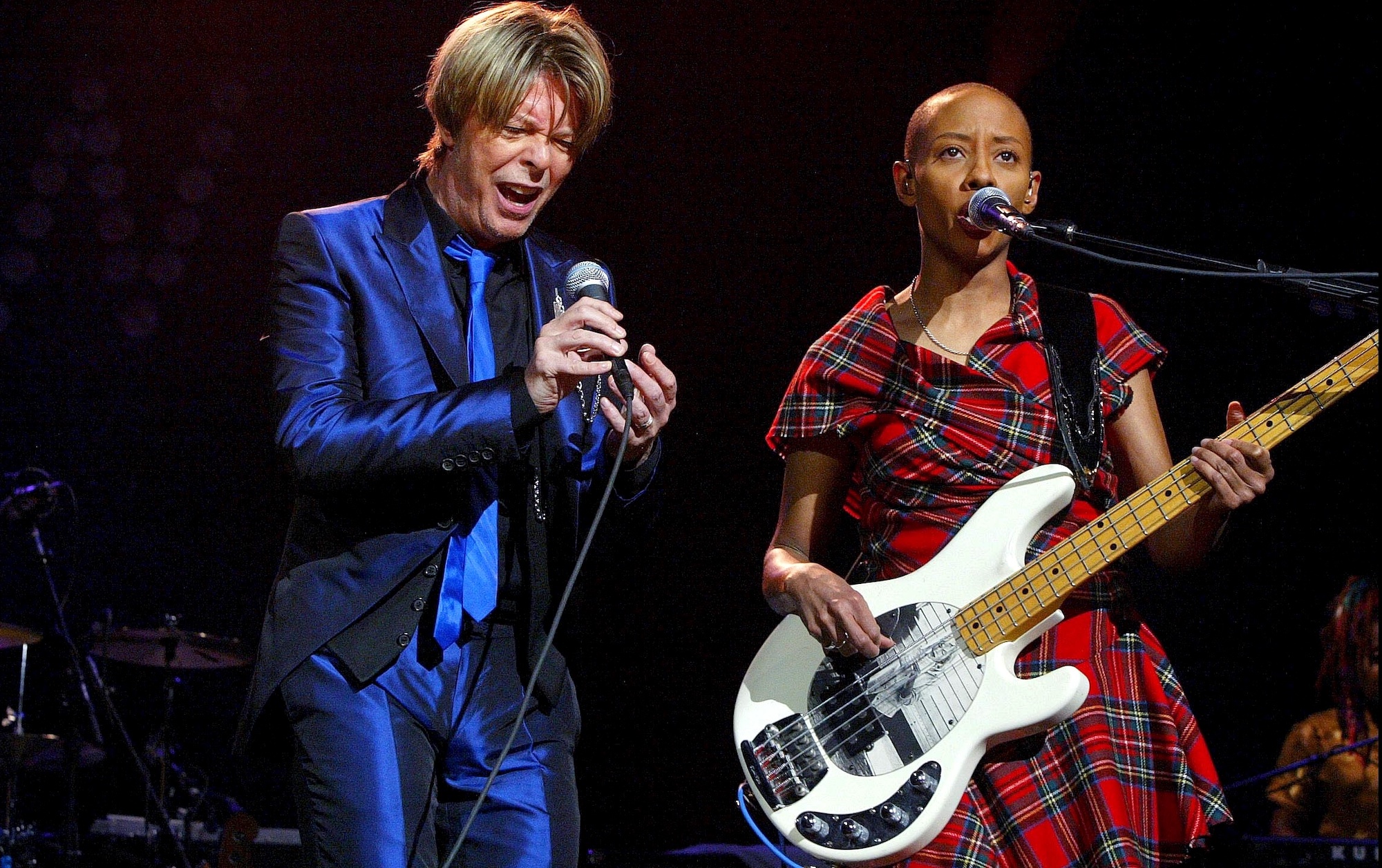
So it's like working with found objects, except that the objects are all from your own closet?
Bowie: “Yeah. We do that an awful lot. The most exciting thing about the way we work is our ability to construct a song in maybe 15 minutes. It's extraordinary how we can develop something very quickly with almost no premeditated ideas about what we're going to do.”
Gabrels: “It's like making a fire with flint. You're huddled around, waiting for a spark. There's no judgment of the idea until it's brought to fruition. After that, you might decide it wasn't a good song after all. But the only way to get it to blossom is to not judge it until it does.”
Bowie: “I have two major approaches at the end of any sequence. If we have a completed section and it's time for the song to go somewhere else, I'll ask, 'What's the last thing you could possibly expect to happen?' and 'What is the one thing in the worst possible taste, so obvious and clichéd that it's laughable?' We try both, and one of the two generally works.
“There's good stupid – a certain Neanderthal quality – and there's stupid stupid. Seven Years in Tibet was a good example of something we started that seemed incredibly hack, with a very predictable, self-serious quality. I said, 'Dump this one, Reeves,' but he worked on it during my absence and turned it into something absolutely magical. It went from being something I wanted off the album to almost my favorite song on the album.”
More than any other new song, it has specific stylistic associations – a certain type of rock/R&B guitar playing. The other tracks exist in a more abstract realm.
Bowie: “Absolutely. What I find interesting in that track is the juxtaposition of a Stax influence with a late-'80s Pixies style. It's the sort of sound you might imagine behind Al Green or Ann Peebles, but set against something very late-'80s.”
Gabrels: “I deliberately evoked a Fleetwood Mac, Albatross feeling, but mainly so I could oppose it to the ton-of-bricks chorus. It's sometimes good to be able to conjure the emotions we automatically associate with classic guitar sounds, but all those tones are sounding more and more like beer commercials. Moosehead destroyed the sound of the Dobro for me!
“I pride myself on being one of the people making the sounds that they'll use to sell sneakers and beer 20 years from now. If we don't do it, there won't be anything to rip off. There is a place in the world for the out-of-phase Strat sound, but it carries so much emotional baggage. I wanted to reclaim for guitar the visceral quality of the new electronic music.
“As much as I love certain classic sounds, I'm not going to disappear up my own ass trying to get the perfect combination of '62 Strat through a Uni-Vibe and a Marshall Plexi and play only what Jimi would play – or what Stevie Ray Vaughan played in emulation of Jimi, or what Kenny Wayne Shepherd plays in emulation of Stevie Ray. I have no desire to be a tone librarian. It's about as interesting to me as the Dewey Decimal System.”
The technofied context in which you're currently working defuses some of the knee-jerk nostalgic associations.
Bowie: “Well of course! Anything out of its natural context will seem to be imbued with completely different information than what it had before. A girl wearing a red dress in a forest will be some strange vision of unexpected exoticism, but a girl wearing a red dress on a catwalk will be highly predictable.
“In art – the 'Big A' word – the information about how the subject is placed is half the story. Framing is terribly important. That's very much a Eno concept. He does more about framing than about actual construction.”
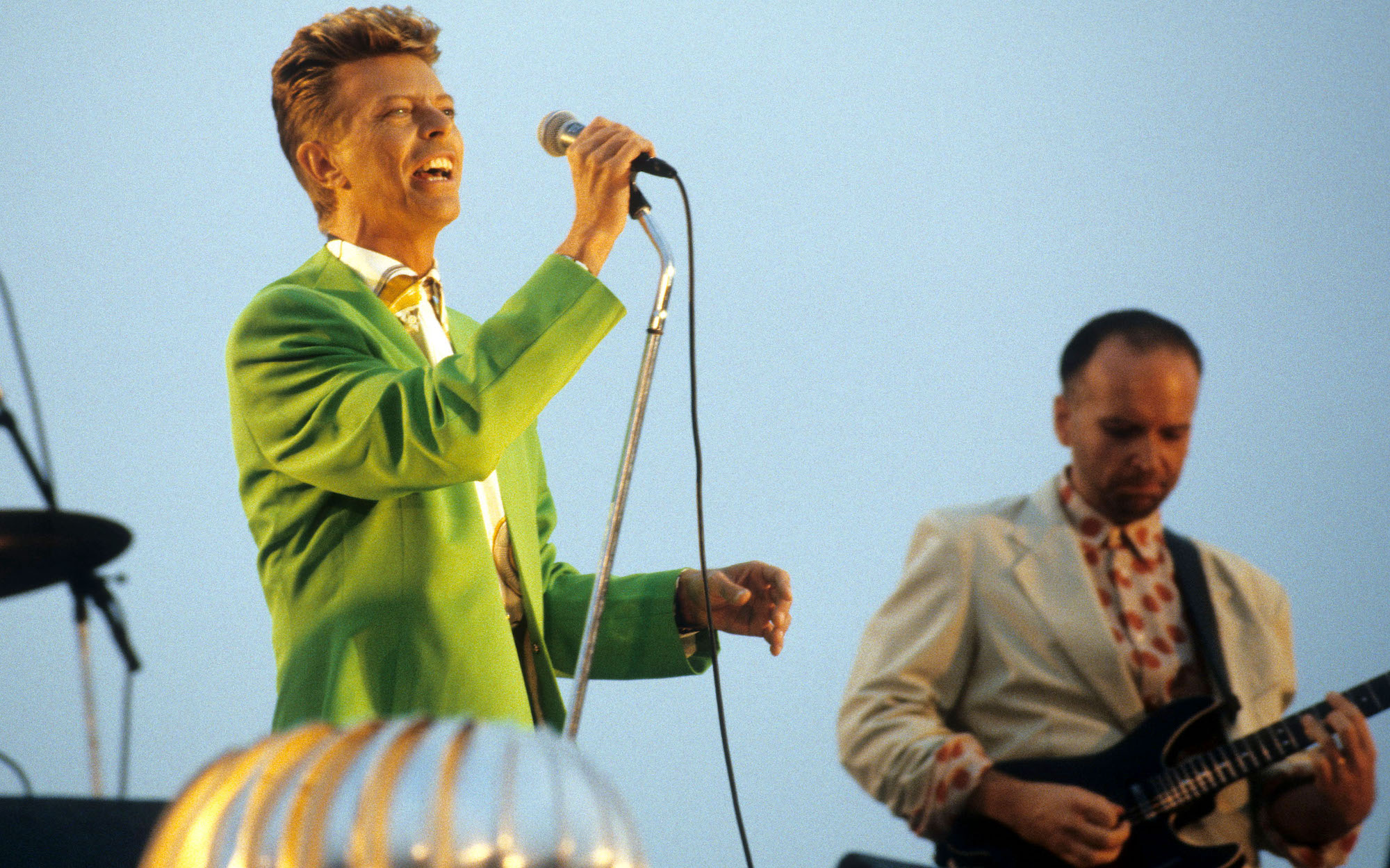
The cut-and-paste nature of the hard-disk medium seems to invite hard, stupid guitar sounds that slap you in the face and disappear before you have the chance to scrutinize them.
Gabrels: “I remember on a [Bowie and Gabrels' late-80s/early '90s band] Tin Machine track like Shopping for Girls where I'd put down track after track of guitar noise. I was always looking for that event, that shard of sound that would hit and then be gone. I was deeply into Nine Inch Nails' Pretty Hate Machine at that time and I was looking for that industrial edge. So the ability to cut things up and move them where I wanted onscreen is what I wished I could have done then.”
Assembling digital shards
The digital format quite literally imposes edges. The hard hit or instant disappearance on the downbeat is very idiomatic, whereas Tin Machine-type rock has a lot of smeary, sustaining sounds – amp buzz, cymbal crashes, room reverb.
Gabrels: “Well, I was too stupid to understand that! But now if I'm trying to, say, record a track with a vibrator playing through the guitar pickups, I run the entire track and then go back to look at the sounds on the computer screen. I might think, 'That's a good one... that's good, but it's a beat late... that's a good one,' and throw out the rest. So the 'shard' aspect can be more fully realized this way.”
Has the hard-disk medium changed the way you see the instrument?
Gabrels: “Well, any improvisation is a series of ideas that you link together, and that's still true in a cut-and-paste situation. But you can be more economical, jumping from good idea to good idea without having to go through the less interesting series of notes that originally connected them.
“You don't see me going through my pockets musically, looking for change. It's not, 'I need a quarter – let's see, here's a penny, here's a dime'; it's more like, 'I need a quarter – here's one.' At that point guitar is merely a sound source for me. It's not about how well I play; it's just sound and its attendant emotion. And this time my goal was to get the guitar into techno, jungle, and trip-hop in a way that doesn't have the cock-rock baggage of electric lead guitar. I think we did it.”
Bowie: “We're going in a different way from what everyone else is doing with drum and bass music. We're trying to give it a sort of complexity. I've not heard anything like the three examples we have on Earthling. It has an immediate aggression and vitality that reminds me of the earliest jungle records. Those guys didn't know much about what they were doing, but they had enough technique to put it together.
“There's this incredible dynamic sense, like it's just coming out of them now. It was as aggressive as any punk thing. That spontaneous combustive atmosphere is terribly important to what we're doing.”
Jungle beats have super-fast snare patterns over a lumbering, half-time bottom end. Do you feel them at the slower tempo or in double-time?
Gabrels: “Well, I'm a pretty slow-moving character, so I always feel it in half-time. It's a lumbering beat with a lot of 32nd-note fills – just like heavy rock! I'm actually getting tired of drum and bass, and I'm interested in the current shift towards darker flavors. David and I felt differently at times about where we wanted this record to go.
“I leaned a bit towards the American industrial side, and he's inclined towards a more Euro sound. Just like some people prefer the Beatles to the Stones or Oasis to Blur, David is a Prodigy fan, while I'm more a fan of Underworld. Ironically, Carl from Underworld is using almost the same setup as me.”
David, on the other hand, played all his parts on a little travel guitar with a built-in amp and speaker.
Bowie: “It's all I need. It's all Reeves would give me! It's a self-esteem thing – I actually don't think I'm worth a better guitar. Why give me a nice Gibson? Give me something I don't feel so precious about. If it's a real cheap guitar, I can do what I want with it, fuck it up, make it do silly things. If you give me a real guitar that real musicians play, I'm suddenly very insecure. I much prefer a cheap Parker.”
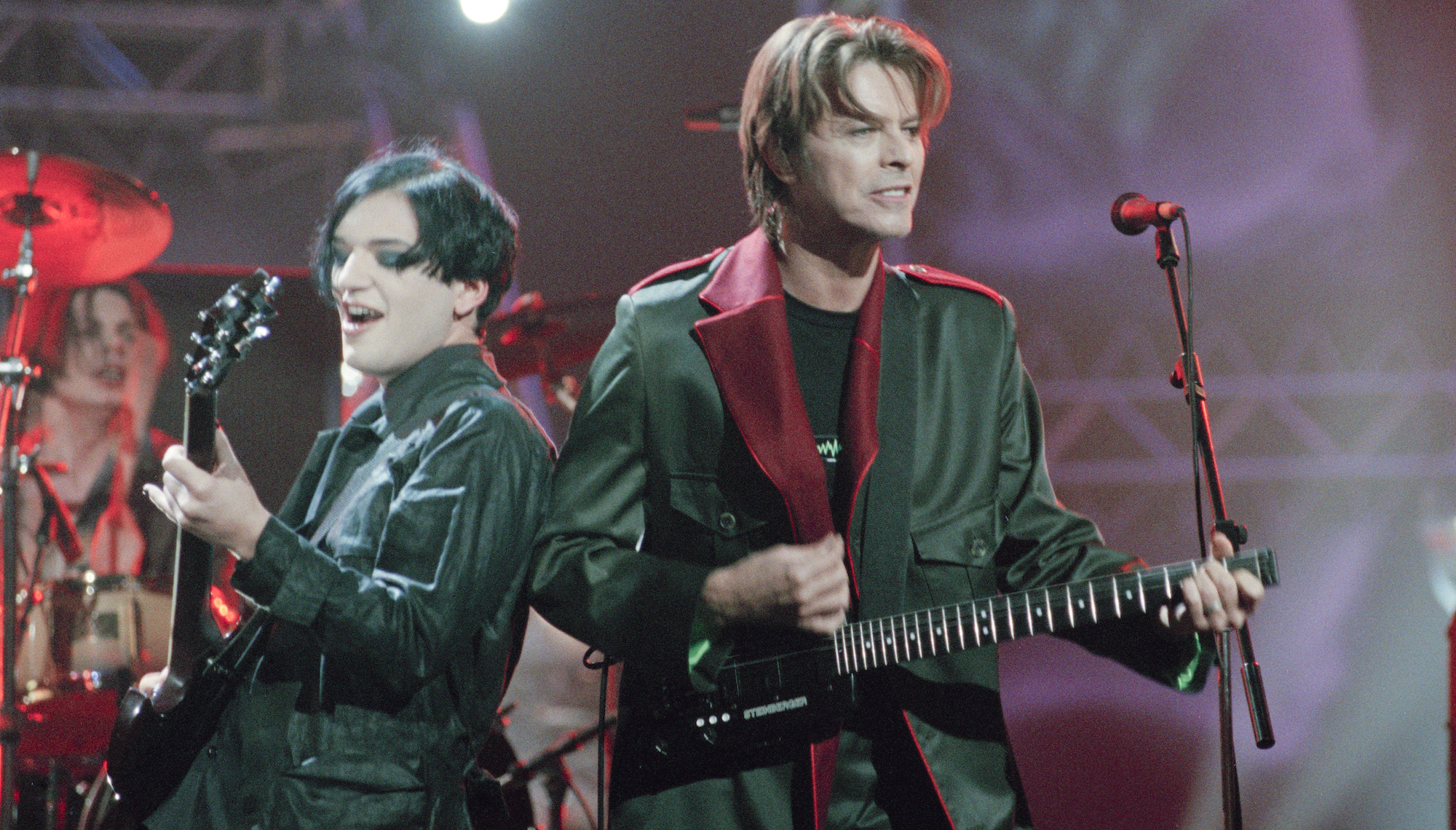
Gabrels: “There's no such thing as a cheap Parker.”
Bowie: “In my case, there are. They give them to me. Or did I pay for that one?”
Gabrels: “That one's mine. It doesn't get much cheaper than that, does it, David?”
So a little stamped-out guitar is relatively free of psychological baggage. Does it ever work in reverse? Do you ever seek out a guitar that's rife with associations?
Bowie: “Maybe something like a Rickenbacker 12-string, a guitar that almost has a manifesto attached to it.”
Gabrels: “Or your one-string Flying V. One string, Floyd Rose, tuned to D.”
Bowie: “That one is beautiful. It's context, always context. For example, I have one of Marc Bolan's old guitars. If we have that in the studio, all the luggage of the guitar comes with it, and it definitely changes the attitude of what we're doing. I can't pick up a guitar and play just anything on it. Whatever guitar I'm given contextualizes the thought.
“I'm sorry to keep using the word 'context,' but it's a governing principle. Context is almost everything. This is something too pretentious for words, but there's another attitude that's very much a part of what I do as a musician and performer. Brecht... [dissolves into laughter] Can you believe I said that?”
Gabrels: “I believe it.”
"You portray the emotion symbolically"
Bowie: “Bertolt Brecht [an early-20th-century German playwright and theorist] believed that it was impossible for an actor to express real emotion in a natural form every night. Instead, you portray the emotion symbolically. You don't try to draw the audience into the emotional content of what you're doing, but give them something to create their own dialog about what you're portraying. You play anger or love through stylistic gesture. The voice doesn't rise and fall and the face doesn't go through all the gambits you would portray as a naturalistic actor.
“I've done that an awful lot throughout my career. A lot of what is perceived as mannered performance or writing is a distancing from the subject matter to allow an audience to have their own association with what I'm writing about. That comes straight from Brecht, who was a major influence on me as a whippersnapper. It applies to any art form. It's a question of creating a space between your subject matter and yourself as an artist. I sing notes that stand in for emotion.
“I honestly couldn't care less about what the subject matter of Earthling is. I need lyrics; I write some lyrics. A guess a lot of subconscious things come through, and that probably says something about me. But it's almost like lyrics standing in for lyrics: [sings] 'Some words go here, and here's some more words.' That's enough. It's almost like when you do an undersketch for a painting. You sketch out what it looks like – a sun here, a house here. That's fine. The enthusiasm fleshes things out.”
Gabrels: “That works instrumentally as well. The undersketch is one of the things you can retain because of recording to hard disk. You can see the pencil line of the house that ended up getting painted. You don't have to lose it. You can make a glorious mistake, and then edit off the mistake, so all you have is the glory.”
Bowie: “Then you have the intrusion of the musicians' abilities. However principled and idealistic your vision, you can't help the intrusions of others. Intentions and expectations are very different for the artist. An artist may have an intention, but by the time he's applied himself to his work, that intention might have gotten lost. Certainly, an audience's expectations of the work are a million miles away from what the artist's intention was.
“It's the space in the middle that's actually the art – the mysterious, almost magical place in the middle where the receptions and intentions become something else.
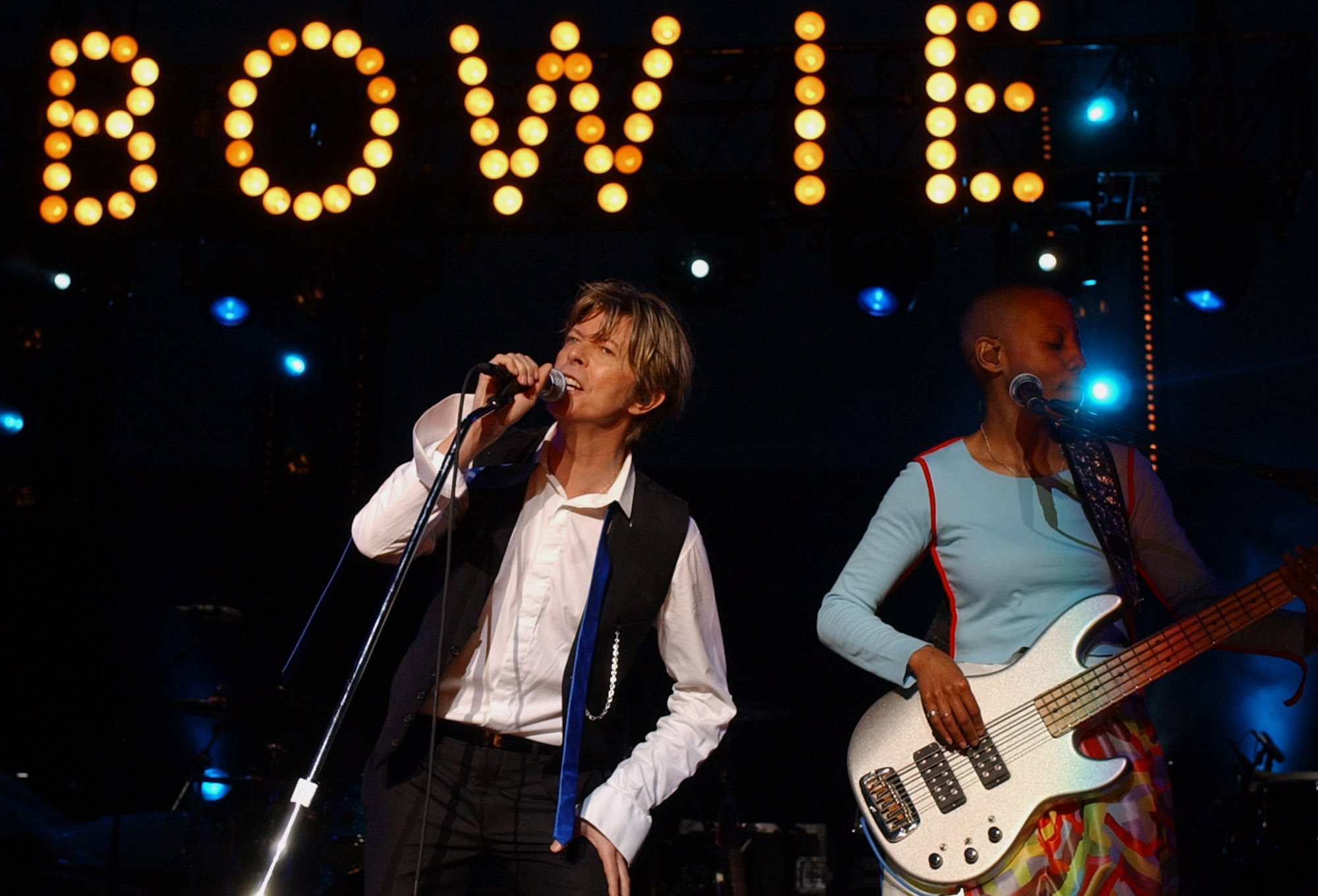
“To my advantage, I haven't got a clue where we're going to take it. It may be the dilettante side of me, but when I know where things are going, I lose interest real fast. That's probably the root of the majority of the critical hostility against me. They don't like the fact that, one, I'm not a rock and roll person and don't care to be considered one, and, two, I treat most of what I do as an exercise in moving textures around.
“It's not my lifeblood or anything. The idea that I'm not honest because of that makes me seem offensive, and that's kind of cool, because I don't know anyone else like that. But not knowing where you're going is what makes it exciting for me. It leaves a permanently open landscape.”
Joe Gore is a guitarist and writer and a former editor for Guitar Player magazine. He has played on albums by Tom Waits, PJ Harvey, Les Claypool, Mark Eitzel, Tracey Chapman, Courtney Love, Eels and more. His book, The Subversive Guitarist is out now and has been acclaimed by Vernon Reid, Gretchen Menn and Dweezil Zappa, among others. For more information, visit his website.
